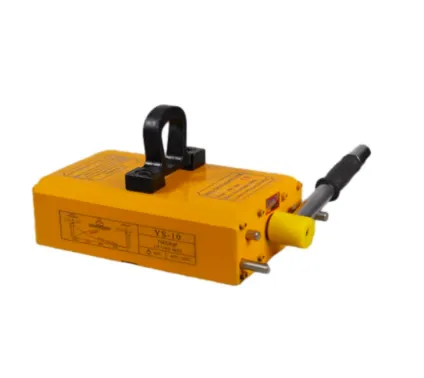Efficient and Safe Lifting with Permanent Magnetic Lifters
In industrial environments where safety, speed, and reliability are paramount, material handling tools must deliver consistent performance under rigorous conditions. One device that stands out for its simplicity and effectiveness is the permanent magnetic lifter. This compact yet powerful lifting solution plays an indispensable role in handling steel plates, bars, and cylindrical components across sectors like shipbuilding, automotive manufacturing, machining, and logistics. By eliminating the need for slings, hooks, or clamps, it streamlines operations while significantly reducing the risk of accidents and downtime.

Compact Power: The Versatility of a Magnetic Lifter
The essence of a магнітний підйомник lies in its design: a solid, durable body housing permanent rare-earth magnets, typically neodymium, that generate a strong magnetic field without relying on an electrical power source. This feature alone offers several advantages—most notably the complete independence from external energy supplies, which not only cuts down on operating costs but also enhances safety in case of power outages.
Operators activate or deactivate the magnetic force using a mechanical lever system, which engages internal magnetic poles to attract or release ferromagnetic materials. This simple control mechanism provides high usability with minimal training and allows for immediate load engagement and release, making the lifter ideal for high-throughput production lines. Additionally, the lifter’s low-profile frame enables it to function effectively in tight working areas or where access to the load is partially restricted.
Heavy-Duty Lifting with a Magnetic Plate Lifter
Steel plates, especially when large, flat, and heavy, pose unique challenges during handling. They are difficult to grip, can warp under pressure, and are prone to slippage when conventional lifting devices are used. A magnetic plate lifter addresses these issues by applying a uniform magnetic force across the surface of the material, distributing the lifting pressure and ensuring a secure hold without deformation.
These lifters are designed to grip flat surfaces cleanly, but many models are also engineered with V-shaped grooves on the base, making them suitable for lifting round materials like steel bars and pipes. This dual-capability increases their operational flexibility across different workflows. In industries such as metal fabrication or construction steel yards, magnetic plate lifters reduce the time and labor needed to move raw or processed materials while minimizing the potential for damage to both the materials and the operators.
Material Handling Optimized: Steel Plate Magnetic Lifter
One of the key advantages of a steel plate magnetic lifter is its ability to support material integrity during the lifting and positioning process. Traditional mechanical clamps may leave scratches or compress the edges of steel surfaces, while slings and chains introduce the risk of unbalanced loads or slipping. In contrast, magnetic lifters offer a non-intrusive solution, securely gripping the material without surface contact from mechanical elements.
In automated or semi-automated operations, these lifters are often integrated with cranes or robotic arms for continuous use. Their consistent performance and low-maintenance requirements make them a long-term asset for any operation focused on precision and productivity. Moreover, because magnetic lifters do not require power during operation, their total cost of ownership is much lower than electromagnets, making them an economically wise investment over time.
Lifting Capacity Matters: Magnetic Lifter 1000kg Performance
When selecting a magnetic lifter, load capacity is a critical factor. A magnetic lifter 1000kg model is among the most commonly used, offering a sweet spot between portability and performance. This mid-range capacity suits a wide variety of industrial applications, from machine shop tasks to warehouse logistics.
Despite being rated for one ton, many of these lifters are engineered with built-in safety factors, often 3 to 1 or more. This means a lifter rated at 1000kg has been tested to support significantly heavier loads under controlled conditions. The inclusion of safety locking mechanisms, often with a double-action release system, further ensures that the load cannot be accidentally dropped during use.
Such lifting tools can be deployed in environments where electrical tools may not be safe or viable—such as outdoor operations or areas where fire hazards are present. With corrosion-resistant finishes, heat-resistant materials, and heavy-duty construction, these lifters remain dependable over years of service, even in demanding conditions.
Permanent magnetic lifter FAQs
What makes a permanent magnetic lifter different from an electromagnetic lifter?
A permanent magnetic lifter uses rare-earth magnets to generate its lifting force, requiring no external power source. In contrast, electromagnetic lifters rely on a continuous supply of electricity to maintain their magnetic field. This makes permanent versions safer in environments prone to power loss and eliminates operating costs related to electricity. Additionally, permanent lifters are more portable and require less maintenance due to the absence of coils or wiring.
Can a magnetic lifter be used on all types of metal materials?
No, magnetic lifters are specifically designed for use with ferromagnetic materials—those that contain iron, nickel, or cobalt. This includes most grades of steel, but not aluminum, brass, copper, or stainless steel with low iron content. It's important to verify the magnetic properties of the target material before use to ensure effective lifting performance and safety.
Is the magnetic field of a steel plate magnetic lifter always active?
No. Though the magnet inside is always “on,” the field can be engaged or disengaged using a mechanical lever. When the lever is in the “off” position, the internal magnetic field is redirected away from the contact surface, allowing the lifter to release the material. This toggle system ensures that the lifter only holds when the operator intends it to, providing both safety and operational control.
How much safety margin is built into a magnetic lifter 1000kg?
Most manufacturers design a magnetic lifter 1000kg with a safety factor of at least 3:1. This means it can theoretically hold up to 3000kg in ideal conditions. However, it's crucial to always adhere to the rated load to account for real-world variables such as surface finish, thickness, material composition, and presence of rust or paint, all of which can affect magnetic strength.
What maintenance is required for a permanent magnetic lifter?
Maintenance is minimal but essential. Operators should regularly inspect the lifting surface for debris, rust, or wear that could interfere with magnetic contact. The mechanical lever and locking mechanisms should be checked for smooth function and integrity. If the lifter is exposed to harsh environments, periodic cleaning and re-coating may be required to prevent corrosion. Always store the lifter in a dry, secure location when not in use to extend its lifespan.
-
Dawei Hand Pallet Truck 1200mm, 2000–5000 KGS Heavy-DutyНовиниNov.17,2025
-
Dawei Hand Pallet Truck, Fork Length 1200mm, 2000–5000kgНовиниNov.17,2025
-
Large Equipment Movers – Safe, Insured & On-Time ServiceНовиниNov.17,2025
-
Machine Moving Dollies | Heavy-Duty, Low-Profile, SafeНовиниNov.17,2025
-
Permanent Lifting Magnet - Heavy-Duty, Safe, Quick ReleaseНовиниNov.11,2025
-
PML 1000 Lifting Magnet - Heavy-Duty, Safe, No PowerНовиниNov.11,2025
-
Large Equipment Movers: Safe, Fast, Certified ProsНовиниNov.11,2025
